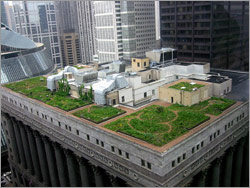About

WIP programs have helped improve the energy efficiency of public buildings and facilities across the United States, including the green roof atop Chicago City Hall.
Credit: Katrin Scholz-Barth
The Weatherization and Intergovernmental Program (WIP) provides funding and technical assistance to its partners in state and local governments, Indian tribes, and international agencies to facilitate the adoption of renewable energy and energy efficiency technologies. Weatherization and Intergovernmental Program staffs work with the EERE Project Management Center to manage grants. Read the Weatherization and Intergovernmental Program Fact Sheet![]() .
.
WIP activities speed the adoption of new technologies and help transfer technologies that are developed by U.S. Department of Energy-funded research to the private sector. WIP manages the largest and most successful energy efficiency programs in the United States: the Weatherization Assistance Program and the State Energy Program.
Weatherization and Intergovernmental Program activities are different from those of most research and development programs in the DOE that focus on basic science and hardware development. WIP projects are more likely to focus on issues such as economic development in rural areas or how renewable energy and energy efficiency projects can improve air quality. In general, WIP activities are characterized by the following:
-
Multiple Technologies
WIP facilitates adoption of a range of technologies that are developed by the DOE Office of Energy Efficiency and Renewable Energy (EERE).
-
Working Across All Energy Market Sectors
WIP sponsors activities in the major energy market sectors—buildings, electric power, industry, and transportation—and works to educate the public, teachers, and students about the benefits of renewable energy and energy efficiency technologies. WIP programs also help state and local agencies improve their energy efficiencies by upgrading public facilities.
-
Partnerships
WIP programs are involved with a broad range of energy stakeholders that cover the breadth of the U.S. economy. WIP staff members consult regularly with the National Governors Association, the National Association of State Energy Officials, the National Council of State Legislatures, the National Association of Counties, the U.S. Conference of Mayors, the National Association of State and Community Service Programs, and many others.
-
Leveraging Federal Resources
Almost every WIP project involves substantial participation and investment by state and local agencies, Indian tribes, and the private sector. In the last evaluation of the State Energy Program (SEP), DOE researchers found that SEP contributed $46 million to renewable energy and energy efficiency projects in the states out of a total expenditure of $540.9 million. States report energy savings of 1.03 million source British thermal units (Btu) for these projects and cost savings on energy bills of $7.22 for every dollar invested by SEP.
If you need to talk to someone in the Weatherization and Intergovernmental Program directly, see the Contacts page.


